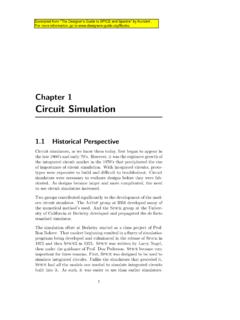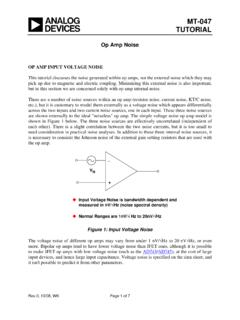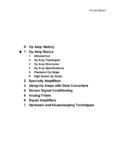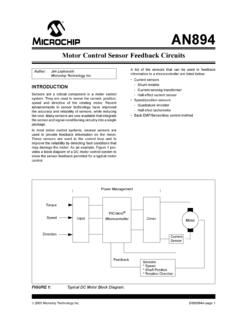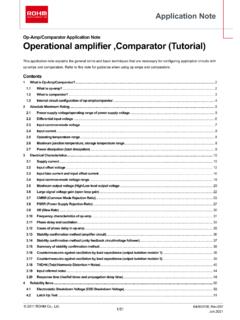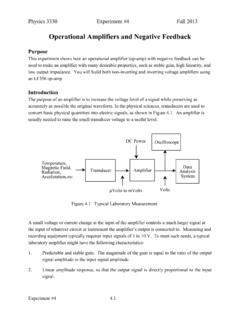Transcription of Cascaded Amplifiers -- Two-Stage Op Amp Design
1 EE 435 Lecture 13 Cascaded Amplifiers -- Two-Stage Op Amp Design Routh-Hurwitz Stability Criteria: A third-order polynomial s3+a2s2+a1s+a0 has all poles in the LHP iff all coefficients are positive and a1a2>a0 Very useful in amplifier and filter Design Can easily determine if poles in LHP without finding poles But tells little about how far in LHP poles may be RH exists for higher-order polynomials as well Review from Last Time Similar implications on amplifier even if not a basic voltage feedback amplifier VOUTVINV1R1R2 AVVOUTVINV1R1R2AV12 OUT1 VFIN2V1R1+VRA = = VR1+1+AR 12 OUT1 VFIN2V1R-VRA = = VR1+1+AR 121R = R +ROUTVVFIN1V21 VAA = = VR1+ARR 2V1 OUTVFIN1V21-RARVA = = VR1+ARR These circuits have same same dead network same characteristic polynomial same poles different zeros D s =1+A
2 (expressed as polynomial) Review from Last Time Cascaded Amplifier Issues Four or more amplifier cascades - problems even larger than for three stages -- seldom used in industry ! -- seldom used in industry ! Two amplifier cascades 0 TOT0 TOTA2 kA4 -- widely used in industry but compensation is essential ! Three amplifier cascades - for ideally identical stages 30 A8 Single-stage Amplifiers -- widely used in industry, little or no concern about compensation Note: Some Amplifiers that are termed single-stage Amplifiers in many books and papers are actually Two-Stage Amplifiers and some require modest compensation. Some that are termed Two-Stage Amplifiers are actually three-stage Amplifiers . These invariable have a very small gain on the first stage and a very large bandwidth.
3 The nomenclature on this summary refers to the number of stages that have reasonably large gain. Review from Last Time Fundamental Amplifier Design Issues Single-Stage Low Gain Op Amps Single-Stage High Gain Op Amps Two-Stage Op Amp Compensation Breaking the Loop Other Basic Gain Enhancement Approaches Other Issues in Amplifier Design Summary Remarks Two-Stage op amp Design It is essential to know the poles of the op amp since there are some rather strict requirements about the relative location of the poles Poles and Zeros of Amplifiers VDDM1M2VB2M3M4 VINVINM5 VDDM6M7VB2M8M9 CLM10 VOUTC1C2C3C4C5C6C7C8 There are a large number of parasitic capacitors in an amplifier (appprox 5 for each transistor) Many will appear in parallel but the number of equivalent capacitors can still be large Order of transfer function is equal to the number of non-degenerate energy storage elements Obtaining the transfer function of a high-order network is a lot of work !
4 Essentially every node in an amplifier has a capacitor to ground and these often dominate the frequency response of the amplifier (but not always) Cascaded Amplifier showing some of the capacitors Pole approximation methods all shunt capacitors these into two sets, those that create low frequency poles and those that create high frequency poles (large capacitors create low frequency poles and small capacitors create high frequency poles) {CL1, .. CLk} and {CH1, .. CHm} find the k low frequency poles, replace all independent voltage sources with ss shorts and all independent current sources with ss opens, all high-frequency capacitors with ss open circuits and, one at a time, select CLh and determine the impedance facing it, say RLh if all other low-frequency capacitors are replaced with ss open circuits.
5 Then an approximation for the pole corresponding to CLh is pLh=-1/(RLhCLh) 4. To find the m high-frequency poles, replace all independent voltage sources with ss shorts and all independent current sources with ss opens, replace all low-frequency capacitors with ss short circuits and, one at a time, select CHh and determine the impedance facing it, say RHh if all other high-frequency capacitors are replaced with ss open circuits. Then the approximation for the pole corresponding to CHh is pHh=-1/(RHhCHh) Pole approximation methods These are just pole approximations but are often quite good Provides closed-form analytical expressions for poles in terms of components of the network that can be managed during Design Provides considerable insight into what is affecting the frequency response of the amplifier Pole approximation methods give no information about zero locations Many authors refer to the pole on a node and this notation comes from the pole approximation method discussed on previous slide Example.
6 Obtain the approximations to the poles of the following circuit R1=1KR2=5KC1=100pFC2=200pFVINVOUTS ince C1 and C2 and small, have two high-frequency poles {C1, C2} R1=1KR2=5KC2=200pFR1=1KR2=5KC1=100pFC2=2 00pFVINVOUTR1=1KR2=5KC1=100pF H22121p = - C R +RH1111p = - C RH2p = - 833 Krad/secH1p = -10M rad/secR1=1KR2=5KC1=100pFC2=200pFVINVOUT H2p = - 821 Krad/secH1p = rad/secIn this case, an exact solution is possible 1 2 1 221 12 22 11 2 1 21R R C C1111s +++s+R CR CR CR R C CTs ( error) (18% error) Basic Two-Stage Cascade F1P1 VINF2P2 VOUT Simple Concept Must decide what to use for the two quarter circuits Can be extended to fully differential on first or second stage Compensation of Basic Two-Stage Cascade F1P1 VINF2P2 VOUTC1 Modest variants of the compensation principle are often used Internally compensated creates the dominant pole on the internal node Output compensated created the dominant pole on the external node F1P1 VINF2P2 VOUTC2 Internally Compensated Output Compensated Everything else is just details !
7 ! Two-Stage Architectural Choices Common Source Cascode Regulated Cascode Folded Cascode Folded Regulated Cascode current Mirror Differential Input Single Ended Input Tail Voltage Tail current Stage 1 Output Compensated Internally Compensated Common Source Cascode Regulated Cascode Folded Cascode Folded Regulated Cascode current Mirror Differential Input Single Ended Input Tail Voltage Tail current Stage 2 Two-Stage Architectural Choices Output CompensatedInternally Compensated6 2 2 6 2 2 2 Plus n-channel or p-channel on each stage 4 2304 Choices !!! Common SourceCascodeRegulated CascodeFolded CascodeFolded Regulated CascodeCurrent MirrorCommon SourceCascodeRegulated CascodeFolded CascodeFolded Regulated CascodeCurrent MirrorDifferentialInputDifferentialInput Single Ended InputSingle Ended InputTail VoltageTail CurrentTail VoltageTail CurrentStage 1 Common SourceCascodeRegulated CascodeFolded CascodeFolded Regulated CascodeCurrent MirrorCommon SourceCascodeRegulated CascodeFolded CascodeFolded Regulated CascodeCurrent MirrorDifferentialInputDifferentialInput Single Ended InputSingle Ended InputTail VoltageTail CurrentTail VoltageTail CurrentStage 2 Two-Stage Architectural Choices Which of these 2304 choices can be used to build a good op amp?
8 All of them !! Output CompensatedInternally CompensatedPlus n-channel or p-channel on each stageCommon SourceCascodeRegulated CascodeFolded CascodeFolded Regulated CascodeCurrent MirrorCommon SourceCascodeRegulated CascodeFolded CascodeFolded Regulated CascodeCurrent MirrorDifferentialInputDifferentialInput Single Ended InputSingle Ended InputTail VoltageTail CurrentTail VoltageTail CurrentStage 1 Common SourceCascodeRegulated CascodeFolded CascodeFolded Regulated CascodeCurrent MirrorCommon SourceCascodeRegulated CascodeFolded CascodeFolded Regulated CascodeCurrent MirrorDifferentialInputDifferentialInput Single Ended InputSingle Ended InputTail VoltageTail CurrentTail VoltageTail CurrentStage 2 Two-Stage Architectural Choices There are
9 Actually a few additional variants so the number of choices is larger Basic analysis of all is about the same and can be obtained from the quarter circuit of each stage A very small number of these are actually used Some rules can be established that provide guidance as to which structure may be most useful in a given application Two-Stage Architectural Choices Guidelines for Architectural Choices Tail current source usually used in first stage, tail voltage source in second stage Large gain usually used in first stage, smaller gain in second stage First and second stage usually use quarter circuits of opposite types (n-p or p-n) Input common mode input range of concern on first stage but output swing of first stage of reduced concern.
10 Output range on second stage of concern. CMRR of first stage of concern but not of second stage Noise on first stage of concern but not of much concern on second stage Two-Stage Architectural Choices Output CompensatedInternally CompensatedPlus n-channel or p-channel on each stage Common SourceCascodeRegulated CascodeFolded CascodeFolded Regulated CascodeCurrent MirrorCommon SourceCascodeRegulated CascodeFolded CascodeFolded Regulated CascodeCurrent MirrorDifferentialInputDifferentialInput Single Ended InputSingle Ended InputTail VoltageTail CurrentTail VoltageTail CurrentStage 1 Common SourceCascodeRegulated CascodeFolded CascodeFolded Regulated CascodeCurrent MirrorCommon SourceCascodeRegulated CascodeFolded CascodeFolded Regulated CascodeCurrent




